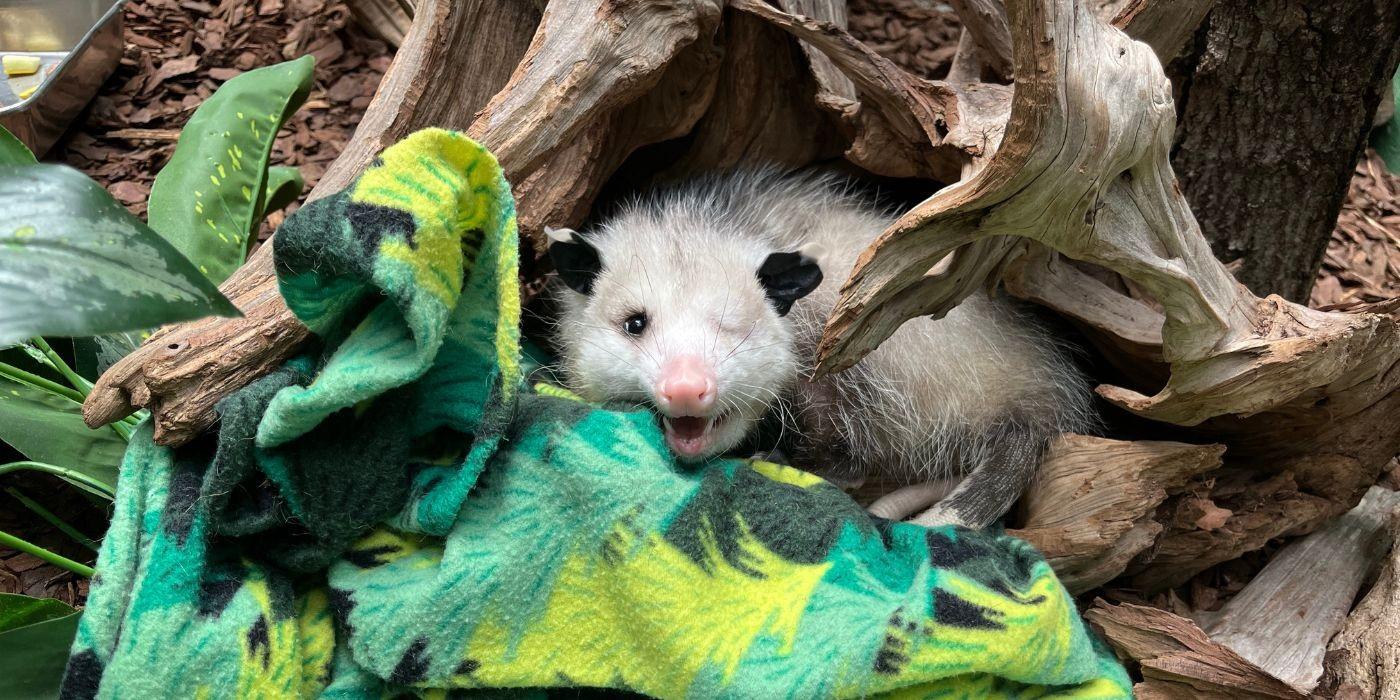Physical Description
Virginia opossums have robust bodies and short legs with sharp claws. Their underfur is usually whitish and tipped in black, but their coloration varies throughout their range. These marsupials are great climbers. They have long, hairless, prehensile tails and feet with an opposable hallux (or thumb) that help them hold on to branches.
Opossums are known for feigning death, or pretending to be dead, whenever they feel threatened or scared. This behavior is mostly displayed by young opossums. Adults will bare their teeth, hiss, screech or flee when threatened.
Size
Males have a body length of 16 inches (40.8 centimeters) with a tail length of 11.6 inches (29.4 centimeters), while female body lengths average 16 inches (40.6 centimeters) with tail lengths of 11 inches (28.1 centimeters). Males weigh between 4.6 and 6.2 pounds (2.1 and 2.8 kilograms) and females range from 4.2-4.6 pounds (1.9–2.1 kilograms).
Native Habitat
Although its name might suggest otherwise, Virginia opossums can be found from Costa Rica to Mexico, as well as in the United States, east of the Rocky Mountains and north into Ontario, Canada. This species was also introduced to the west coast of the U.S. and British Columbia, Canada, and is still expanding northward. Virginia opossums occupy a variety of habitats, ranging from deserts to wet meadows, but prefer living in woodlands and thickets near a source of water. They can be found from lowlands to elevations of 3,000 meters.
Lifespan
In the wild, Virginia opossums may live to be 1.5 to 2 years old. In human care, they typically live to age 3 or 4.
Food/Eating Habits
Virginia opossums are opportunistic feeders that eat a variety of foods depending on the season. They are omnivorous and will eat small mammals, birds, insects, worms, plant material, fruits and seeds. Depending on their habitat, they might also eat reptiles or amphibians.
At the Smithsonian's National Zoo, the Virginia opossum eats fish, meat, eggs, pellets, fruits, vegetables and mushrooms.
Sleep Habits
They are nocturnal and solitary, staying active between dusk and dawn. Virginia opossums do not hibernate but reduce their activity during the coldest seasons.
Reproduction and Development
Like other marsupials, Virginia opossums are polygynous, meaning that males may have multiple female partners during the mating season, which starts in January or February and extends into June or July. Both male and female opossums become sexually mature within their first year of life.
On average, Virginia opossums have two litters per year, but this varies depending on their specific location. Females in warmer climates may have three litters per year after a gestation period of 12 to 13 days. Each litter has four to 25 young that are about 0.5 inches (14 millimeters) long when born. The young opossums climb into their mother’s pouch right after birth and remain there for about two months, until fully developed. The young are weaned after 105 days but can start eating solid food before weaning.
Conservation Efforts
Virginia opossums are a widespread species. They are hunted and trapped for food and fur in some areas, but are more threatened by collisions with motor vehicles. Helping maintain healthy habitats for wildlife will help protect this species.
Help this Species
Reduce, reuse and recycle — in that order! Cut back on single-use goods, and find creative ways to reuse products at the end of their life cycle. Choose recycling over trash when possible.
Share the story of this animal with others. Simply raising awareness about this species can contribute to its overall protection.
Meet the Animals
The Zoo is home to one male Virginia opossum named Basil. He was found injured from a predator attack and brought to City Wildlife, where their team treated his wounds and helped him heal. Unfortunately, his injuries were severe enough that he was deemed non-releasable. Now, he lives the Small Mammal House and serves as a representative for his species.
Smithsonian's National Zoo and Conservation Biology Institute. (n.d.). Virginia opossum. Retrieved January 10, 2026, from https://nationalzoo.si.edu/animals/virginia-opossum
Animal News



